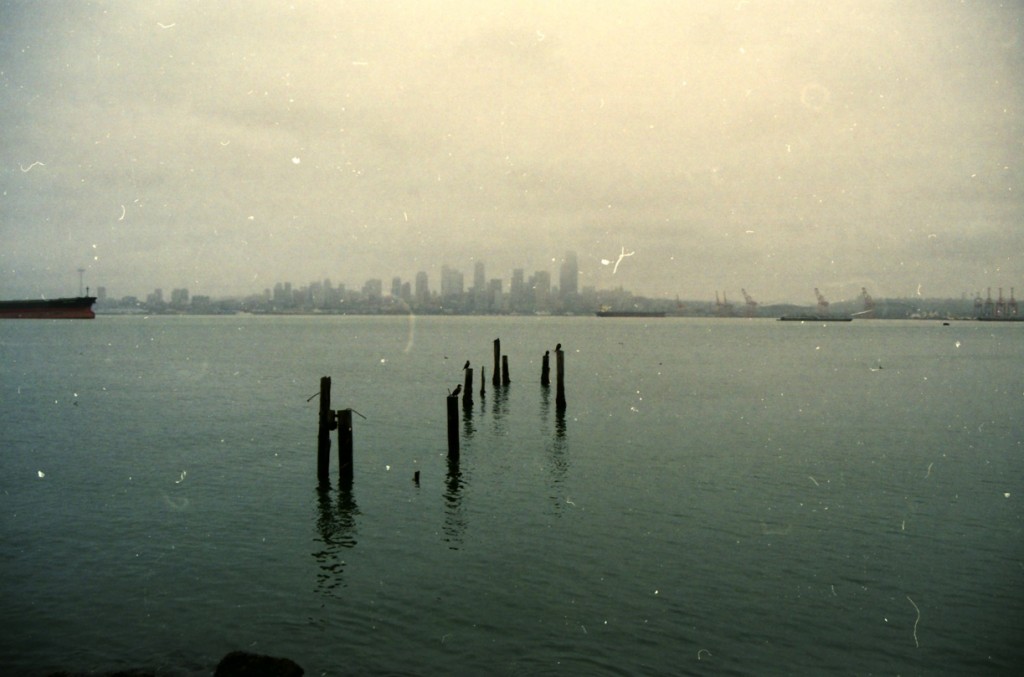
“Well, you win the award for Mr. Conviviality,” an elderly woman said to me as she deboarded on the tail end of the 10. It was the conclusion of an overloaded, chatty, energetic journey.
“Aw! You’re so kind!”
As I drove away I was flattered by something besides her sentiment. She was making the assumption, bus driver or no bus driver, that I in my blue collar knew what the word conviviality meant. That benefit of the doubt felt good.
A day later, I was a northbound 14 at Third and Columbia. As per my usual, I plowed up to the head of the zone, the better to make room for other coaches behind me. Some passengers wait at the head of the zone. Others wait in a less populated part of the bus stop, ambling forward when the time is right. I opened the doors and looked through my mirror down the length of the zone. In the evening dimness I could discern a shape-shifting beast rollicking up the sidewalk. This man is best summed up as a lithe, agile swagger of a shadow, half of him seemingly comprised of swinging black back-length dreads, the other half made of handfuls of slack, billowing black fabric.
“AAAAYYY!” he wailed into the night. Translated, that means, “driver, please wait a moment; I’m nearly at the doors.”
“Hey, there he is,” I said as he swam up the staircase.
“Wha’s goin’ on,”
“Not a lot. How’re you?”
“Just gimme a, gimme a second,”
“Oh yeah, we gotchu.”
Sometimes people seem as if they need three hands, to carry everything they’re holding. This fellow needed at least ten. From every pocket and fold of fabric it seemed as if scraps of life were escaping. In Underworld (my vote for the great twentieth-century novel), Don Delillo writes of garbage as the tactile evidence of all human activity, proof of a million impulses and longings, passions, kindness, selfishness and generosity- the totality of our experience in the form of clues and remnants.
Our man on the 14 reaches in every direction. Debris falls from him continuously, like a cloud system dispersing rain, receipts and kleenex, wrappers and more, and he’s trying to gather every escaping shred, all the while doing his best to hold up his expansively sagging pants. He’s in no condition to find his transfer, and I hand him a new one. He thanks me profusely.
At the end of his ride a doctor’s prescription falls to the floor. A passenger and myself simultaneously point it out, and he’s loudly grateful, snatching it up. After he ricochets out of the bus he darts back up, holding his transfer, saying:
“Hey! Will this shit suffice?”
I respond with, “Yup yup, good ’til the end of the night!”
Internally I was thinking, suffice??? Seattle really is the most educated city in the country!* How lucky I am to be in real life, and not trapped inside a stereotype-laden movie. I grinned in the darkness, thinking of the Mark Twain quote wherein he expresses that the difference between truth and fiction is that fiction needs to be plausible.
Article Note: *Read more from Fast Company, The Washington Post and Brookings Institution, and CNN.
Nathan Vass is an artist, filmmaker, photographer, and author by day, and a Metro bus driver by night, where his community-building work has been showcased on TED, NPR, The Seattle Times, KING 5 and landed him a spot on Seattle Magazine’s 2018 list of the 35 Most Influential People in Seattle. He has shown in over forty photography shows is also the director of nine films, six of which have shown at festivals, and one of which premiered at Henry Art Gallery. His book, The Lines That Make Us, is a Seattle bestseller and 2019 WA State Book Awards finalist.



